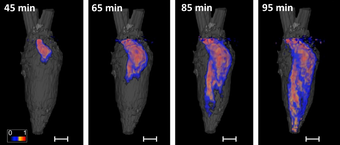Tracer Technologies
The transport and allocation of molecules such as photoassimilates are critical for survival and performance of plants.
Short lived radiotracers can be administered non-invasively to the plant and due to their radioactive properties, the radiotracer can be detected non-invasively from outside the plant, even if they are located deep within the plant body or within roots buried in the soil. This allows conclusions on transport properties and current allocation patterns in the plant.
For the detection of radiotracers we use two groups of instruments with different advantages and challenges:
Scintillation detectors
The basic approach consists of scintillation detectors with subsequent electronics placed along a linear transport pathway (e.g. photoassimilates within a stem) that will detect radioactivity from a source site to a sink (e.g. 11CO2 labelled leaf to root). From the radioactivity measured over time, parameters such as loss along the transport pathway and flow velocity can be calculated using a mathematical model (Bühler et al., 2014).
Positron Emission Tomography (PET)
PET allows for detection and three dimensional (3D) mapping of positron emitting radionuclides (e.g. 11C, 15O, 13N). The carbon isotope 11C allows for characterizing transport and allocation of photoassimilates in a dynamic manner for studying developmental changes and plant responses to environmental cues (Jahnke et al., 2009, de Schepper et al., 2013). Currently, three plant dedicated PET systems are in (or will come into) operation at IBG-2:
phenoPET includes last generation digital photon counter technology (Streun et al., 2014) and integrates all corrections for quantification of radioactivity in 3D. The system provides a FOV of 180mm in diameter and 190mm in height and will have much higher detection sensitivity than PlanTIS.

Mathematical modeling for quantitative data analysis of tracer transport

Data obtained from tracer transport experiments typically need model based data analysis to retrieve a quantitative characterization of transport properties. For this purpose we developed compartmental tracer transport models (Bühler et al. 2014) which describe axial convection and diffusion as well as exchange of tracer between compartments, and are defined by partial differential equations (PDEs). Depending on the specific experimental situation, different models are used to fit the data. Special attention is on highly efficient implementation of the numerical procedures to solve the PDEs (Bühler et al. 2017). In our further development we focus on automated data processing and model based experimental design of PET measurements (Bühler et al. 2018).
Selected Publications
Agyei K, Detring J, Metzner R, Huber G, Pflugfelder D, Eini O, Varrelmann M, Mahlein A-K, Koller R. 2025. Syndrome “basses richesses” disease induced structural deformations and sectorial distribution of photoassimilates in sugar beet taproot revealed by combined MRI-PET imaging. Plant Phenomics: 100053.
Lanzrath H, von Lieres E, Metzner R, Huber G. 2025. Analyzing time activity curves from spatio-temporal tracer data to determine tracer transport velocity in plants. Mathematical Biosciences 383: 109430.
Hinz C, Jahnke S, Metzner R, Pflugfelder D, Scheins J, Streun M, Koller R. 2024. Setup and characterisation according to NEMA NU 4 of the phenoPET scanner, a PET system dedicated for plant sciences. Physics in Medicine & Biology 69(5): 055019.
Yu P, Li C, Li M, He X, Wang D, Li H, Marcon C, Li Y, Perez-Limón S, Chen X, et al. 2024. Seedling root system adaptation to water availability during maize domestication and global expansion. Nature Genetics 56(6): 1245-1256.
Metzner R, Chlubek A, Bühler J, Pflugfelder D, Schurr U, Huber G, Koller R, Jahnke S. 2022. In Vivo Imaging and Quantification of Carbon Tracer Dynamics in Nodulated Root Systems of Pea Plants. Plants 11(5): 632.
Bühler, J., von Lieres. E., Huber, G. (2018) Model-based design of long-distance tracer transport experiments in plants. Frontiers in Plant Science 9: 773. doi: 10.3389/fpls.2018.00773
Bühler, J., Huber, G., von Lieres. E. (2017) Finite volume schemes for the numerical simulation of tracer transport in plants. Mathematical Biosciences 288: 14-20
Bühler, J. von Lieres. E., Huber, G. (2014) A class of compartmental models for long-distance tracer transport in plants. Journal of Theoretical Biology 341: 131-142.
De Schepper, V., Bühler, J., Thorpe, M., Roeb, G., Huber, G., Van Dusschoten, D., Jahnke, S., Steppe, K. (2013) 11C-PET imaging reveals transport dynamics and sectorial plasticity of oak phloem after girdling. Frontiers in Plant Science 4:200. doi: 10.3389/fpls.2013.00200
Beer, S., Streun, M., Hombach, T., Buehler, J., Jahnke, S., Khodaverdi, M., et al. (2010) Design and initial performance of PlanTIS: a high-resolution positron emission tomograph for plants. Physics in Medicine and Biology 55, 635-646. doi: 10.1088/0031-9155/55/3/006.
Jahnke, S., Menzel, M.I., Van Dusschoten, D., Roeb, G.W., Bühler, J., Minwuyelet, S., et al. (2009) Combined MRI-PET dissects dynamic changes in plant structures and functions. Plant Journal 59, 634-644. doi: 10.1111/j.1365-313X.2009.03888.x
Contact
- Institute of Bio- and Geosciences (IBG)
- Plant Sciences (IBG-2)
Room 202
Dr. Ralf Metzner
Stellvertretender Leiter "Enabling Technologies", Teamleiter "Plant Radiotracers"
- Institute of Bio- and Geosciences (IBG)
- Plant Sciences (IBG-2)
Room 216


